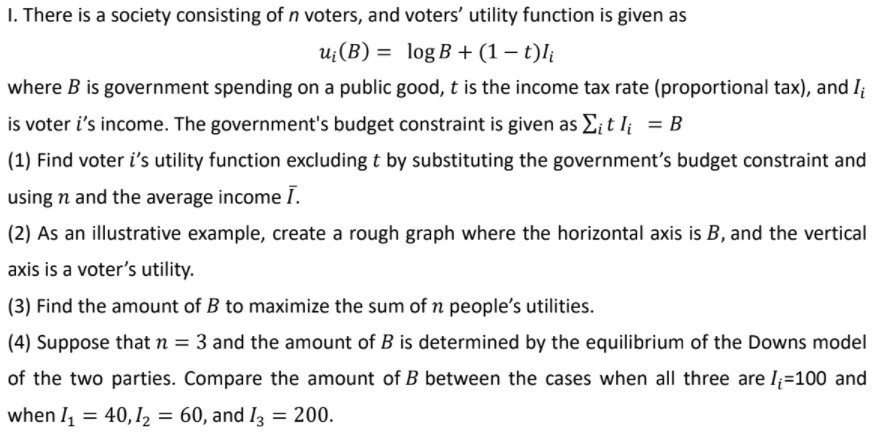(3) Find the amount of B to maximize the sum of n people's utilities. (4) Suppose that n = 3 and the amount of B is determined by the equilibrium of the Downs model of the two parties. Compare the amount of B between the cases when all three are I₁=100 and when I₁ = 40, 1₂ = 60, and I3 = 200.
(3) Find the amount of B to maximize the sum of n people's utilities. (4) Suppose that n = 3 and the amount of B is determined by the equilibrium of the Downs model of the two parties. Compare the amount of B between the cases when all three are I₁=100 and when I₁ = 40, 1₂ = 60, and I3 = 200.
Chapter12: The Partial Equilibrium Competitive Model
Section: Chapter Questions
Problem 12.11P
Related questions
Question
Only answer 3 and 4.

Transcribed Image Text:I. There is a society consisting of n voters, and voters' utility function is given as
u;(B) = log B + (1 – t)l;
where B is government spending on a public good, t is the income tax rate (proportional tax), and I
is voter i's income. The government's budget constraint is given as E¡ t I¡ = B
(1) Find voter i's utility function excluding t by substituting the government's budget constraint and
using n and the average income I.
(2) As an illustrative example, create a rough graph where the horizontal axis is B, and the vertical
axis is a voter's utility.
(3) Find the amount of B to maximize the sum of n people's utilities.
(4) Suppose that n = 3 and the amount of B is determined by the equilibrium of the Downs model
of the two parties. Compare the amount of B between the cases when all three are l;=100 and
when I = 40,12 = 60, and I3 = 200.
Expert Solution
This question has been solved!
Explore an expertly crafted, step-by-step solution for a thorough understanding of key concepts.
Step by step
Solved in 4 steps with 16 images

Knowledge Booster
Learn more about
Need a deep-dive on the concept behind this application? Look no further. Learn more about this topic, economics and related others by exploring similar questions and additional content below.Recommended textbooks for you


Principles of Microeconomics (MindTap Course List)
Economics
ISBN:
9781305971493
Author:
N. Gregory Mankiw
Publisher:
Cengage Learning

Principles of Economics (MindTap Course List)
Economics
ISBN:
9781305585126
Author:
N. Gregory Mankiw
Publisher:
Cengage Learning


Principles of Microeconomics (MindTap Course List)
Economics
ISBN:
9781305971493
Author:
N. Gregory Mankiw
Publisher:
Cengage Learning

Principles of Economics (MindTap Course List)
Economics
ISBN:
9781305585126
Author:
N. Gregory Mankiw
Publisher:
Cengage Learning

Principles of Economics, 7th Edition (MindTap Cou…
Economics
ISBN:
9781285165875
Author:
N. Gregory Mankiw
Publisher:
Cengage Learning

